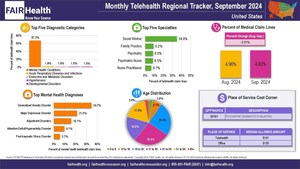Mental Health Conditions, the Top Telehealth Diagnostic Category, Rose in Percentage of Telehealth Claim Lines Nationally and in Every Region in February 2024
In February, Telehealth Utilization Overall Increased Nationally and in Midwest and West, but Fell in Northeast and South, according to FAIR Health's Monthly Telehealth Regional Tracker
Nationally and in Every Region, the Median Allowed Amount for a 45-Minute Psychotherapy Visit Was Higher via Telehealth Than in an Office Setting
NEW YORK, May 15, 2024 /PRNewswire/ -- In February 2024, mental health conditions continued as the top telehealth diagnostic category nationally and in every region, and grew as a percentage of telehealth claim lines nationally and in every region, according to FAIR Health's Monthly Telehealth Regional Tracker.1 Nationally, mental health conditions rose from 66.3 percent of telehealth claim lines in January to 67.2 percent in February. Regionally, the largest increase was in the South (increasing from 56.0 percent to 57.1 percent), while the smallest increase was in the Midwest (from 72.3 percent to 72.5 percent). The data represent the privately insured population, excluding Medicare Fee-for-Service, Medicare Advantage and Medicaid. These findings follow the release of FAIR Health's mental health white paper in late April: Trends in Mental Health Conditions: An Analysis of Private Healthcare Claims.
COVID-19 was not in the top five diagnostic categories nationally or in any region in February 2024. In January, it had been ranked fourth in the Northeast.
Mental Health Diagnoses
Generalized anxiety disorder remained the top mental health telehealth diagnosis nationally and in every region. In February, it accounted for more than 30 percent of mental health telehealth claim lines everywhere. The largest share was still in the Northeast at 38.4 percent, up from 38.1 percent in January.
Nationally and in all four census regions, the top five mental health diagnoses in February were identical to each other: generalized anxiety disorder, major depressive disorder, adjustment disorders, attention-deficit/hyperactivity disorder and post-traumatic stress disorder (PTSD). In the South, bipolar disorder had ranked at number five in January, but in February, PTSD filled that position, matching the other regions and the national ranking.
Utilization
In February 2024, overall telehealth utilization increased nationally and in the Midwest and West, but fell in the Northeast and South. Nationally, medical claim lines associated with telehealth rose slightly from 4.78 percent in January to 4.79 percent in February, a 0.3 percent increase. In the Midwest, the share of claim lines rose 2.3 percent, while in the West it rose 3.0 percent. In the Northeast, however, there was a decrease of 4.1 percent, and in the South, a decrease of 1.2 percent.
Specialties
In February, as in January, social worker was the top telehealth provider specialty nationally and in all regions. At the national level, social worker accounted for 35.2 percent of telehealth claim lines. Across regions, it varied from 29.3 percent in the South to 42.1 percent in the Midwest.
Nationally, and in the South and West, family practice remained in the top five specialties in February. Family practice still did not rank among the top five in the Northeast or Midwest.
Age
In February, as in January, the age group 31 to 40 accounted for the largest share of telehealth claim lines nationally and in the South and West, while the age group 19 to 30 accounted for the largest share in the Midwest and Northeast.
The percentage of telehealth claim lines associated with each age group varied from January to February 2024. The largest change was in the age group 0 to 9 at the national level, which increased in its share of telehealth claim lines by 17.9 percent (rising from 2.6 percent to 3.0 percent).
Costs
Nationally and in every region, the median allowed amount2 for CPT®3 90834 (psychotherapy, 45 minutes) in February was higher when rendered via telehealth than in an office. Nationally and in the Northeast, the cost was $92 via telehealth and $88 in an office; in the South, it was $85 via telehealth and $77 in an office. In the Midwest, the cost was $93 via telehealth and $82 in an office, and in the West, the cost was $105 via telehealth and $93 in an office.
About the Monthly Telehealth Regional Tracker
Launched in May 2020 as a free service, the Monthly Telehealth Regional Tracker uses FAIR Health data to track how telehealth is evolving from month to month. An interactive map of the four US census regions allows the user to view an infographic on telehealth in a specific month in the nation as a whole or in individual regions. Each year, the infographic introduces varied views into telehealth utilization. In this fifth iteration of the Monthly Telehealth Regional Tracker, each infographic shows month-to-month changes in volume of telehealth claim lines; that month's top five diagnostic categories, mental health diagnoses and specialties; age distribution; and the Place of Service Cost Corner, which compares median allowed amounts for a specific procedure provided via telehealth to the same procedure provided in an office;.
FAIR Health President Robin Gelburd stated: "We are happy to share these varying windows into telehealth utilization as it continues to evolve. This is one of the many ways we pursue our healthcare transparency mission."
For the Monthly Telehealth Regional Tracker, click here.
Follow us on X @FAIRHealth
About FAIR Health
FAIR Health is a national, independent nonprofit organization that qualifies as a public charity under section 501(c)(3) of the federal tax code. It is dedicated to bringing transparency to healthcare costs and health insurance information through data products, consumer resources and health systems research support. FAIR Health possesses the nation's largest collection of private healthcare claims data, which includes over 46 billion claim records and is growing at a rate of over 3 billion claim records a year. FAIR Health licenses its privately billed data and data products—including benchmark modules, data visualizations, custom analytics and market indices—to commercial insurers and self-insurers, employers, providers, hospitals and healthcare systems, government agencies, researchers and others. Certified by the Centers for Medicare & Medicaid Services (CMS) as a national Qualified Entity, FAIR Health also receives data representing the experience of all individuals enrolled in traditional Medicare Parts A, B and D, which accounts for a separate collection of over 47 billion claim records; FAIR Health includes among the private claims data in its database, data on Medicare Advantage enrollees. FAIR Health can produce insightful analytic reports and data products based on combined Medicare and commercial claims data for government, providers, payors and other authorized users. FAIR Health's systems for processing and storing protected health information have earned HITRUST CSF certification and achieved AICPA SOC 2 Type 2 compliance by meeting the rigorous data security requirements of these standards. As a testament to the reliability and objectivity of FAIR Health data, the data have been incorporated in statutes and regulations around the country and designated as the official, neutral data source for a variety of state health programs, including workers' compensation and personal injury protection (PIP) programs. FAIR Health data serve as an official reference point in support of certain state balance billing laws that protect consumers against bills for surprise out-of-network and emergency services. FAIR Health also uses its database to power a free consumer website available in English and Spanish, which enables consumers to estimate and plan for their healthcare expenditures and offers a rich educational platform on health insurance. An English/Spanish mobile app offers the same educational platform in a concise format and links to the cost estimation tools. The website has been honored by the White House Summit on Smart Disclosure, the Agency for Healthcare Research and Quality (AHRQ), URAC, the eHealthcare Leadership Awards, appPicker, Employee Benefit News and Kiplinger's Personal Finance. For more information on FAIR Health, visit fairhealth.org.
Contact:
Rachel Kent
Executive Director of Communications and Marketing
FAIR Health
646-396-0795
[email protected]
1 A claim line is an individual service or procedure listed on an insurance claim.
2 An allowed amount is the total fee paid to the provider under an insurance plan. It includes the amount that the health plan pays and the part the patient pays under the plan's in-network cost-sharing provisions (e.g., copay or coinsurance if the patient has met the deductible).
3 CPT © 2023 American Medical Association (AMA). All rights reserved.
SOURCE FAIR Health

WANT YOUR COMPANY'S NEWS FEATURED ON PRNEWSWIRE.COM?
Newsrooms &
Influencers
Digital Media
Outlets
Journalists
Opted In





Share this article